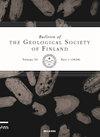Hiekkapohja hydrothermal system – ore mineral, lithogeochemical and paleomagnetic evidence from the Paleoproterozoic Central Finland Granitoid Complex
IF 1.3
4区 地球科学
Q2 GEOLOGY
引用次数: 1
Abstract
The Paleoproterozoic Svecofennian Central Finland Granitoid Complex (CFGC) has been regarded as an area of low mineralisation potential. The Hiekkapohja area, 20km north-east of the town of Jyväskylä, host a concentration of variable metalliferous showings. Samples from mineralised boulders and outcrops display variable combinations of anomalously high concentrations of Cu, Mo, Zn, Pb, W, Pb, Ag, As, and Au. The area is composed mainly of peraluminous and ferroan granitoids. The dominant porphyritic Hiekkapohja granodiorite (~1.88 Ga) is cross-cut by the equigranular Soimavuori granite of similar age. The porphyritic Lehesvuori granite on the western side of the study area represents marginally older (~1.89 Ga) magmatism. The paragenetic sequence of the ore minerals shows that the Hiekkapohja area has been affected by at least two separate stages of hydrothermal activity. The first mineralisation stage was widespread, crystallising typically chalcopyrite, pyrrhotite, sphalerite, galena, arsenopyrite, magnetite and Ag-bearing minerals. After the first stage, a low temperature oxidising phase formed hematite and marcasite. The second mineralisation stage enclosed low temperature minerals, such as marcasite and native Ag and Ag-minerals, as inclusions inside chalcopyrite, pyrite, pyrrhotite, sphalerite, and arsenopyrite. The mineralised samples typically display signs of K-metasomatism and less commonly signs of propylitic alteration. During the second mineralisation stage the fluid flow was controlled by the dominant 120°–135° trending shear zones. Both the hydrothermal activity and the regional geology indicate that porphyry type ore forming processes have occurred in the Hiekkapohja area. Paleoproterozoic resetting of the remanent magnetisation is further evidence for the role of the hydrothermal system.Hiekkapohja热液系统——古元古代芬兰中部花岗岩杂岩的矿石、岩石地球化学和古地磁证据
古元古代芬兰中部Svecofennian花岗质杂岩(CFGC)被认为是一个矿化潜力较低的区域。Hiekkapohja地区位于Jyväskylä镇东北20公里处,是各种金属展示的集中地。矿化巨砾和露头的样品显示出异常高浓度的Cu、Mo、Zn、Pb、W、Pb、Ag、As和Au的可变组合。该区域主要由过铝质和铁质花岗岩组成。主要的斑状Hiekkapohja花岗闪长岩(~1.88 Ga)被类似年龄的等粒Soimavuori花岗岩横切。研究区西侧的斑状Lehesvuori花岗岩代表稍老(~1.89 Ga)的岩浆作用。矿石的共生序列表明,Hiekkapohja地区至少受到两个独立的热液活动阶段的影响。第一个矿化阶段分布广泛,通常结晶黄铜矿、磁黄铁矿、闪锌矿、方铅矿、毒砂、磁铁矿和含银矿物。在第一阶段之后,低温氧化相形成赤铁矿和marcasite。第二个矿化阶段包含低温矿物,如marcasite和天然Ag和Ag矿物,作为黄铜矿、黄铁矿、磁黄铁矿、闪锌矿和毒砂内部的包裹体。矿化样品通常表现出钾交代作用的迹象,而不太常见的丙基蚀变迹象。在第二个矿化阶段,流体流动受到主导的120°-135°走向剪切带的控制。热液活动和区域地质都表明,Hiekkapohja地区发生了斑岩型成矿过程。古元古代残余磁化的重置是热液系统作用的进一步证据。
本文章由计算机程序翻译,如有差异,请以英文原文为准。
求助全文
约1分钟内获得全文
求助全文
来源期刊
CiteScore
1.30
自引率
0.00%
发文量
5
审稿时长
>12 weeks
期刊介绍:
Bulletin of the Geological Society of Finland (BGSF) publishes research articles and short communications in all branches of geosciences. Contributions from outside Finland are welcome, provided that they contain material relevant to Finnish geology or are of general interest.

 求助内容:
求助内容: 应助结果提醒方式:
应助结果提醒方式:


